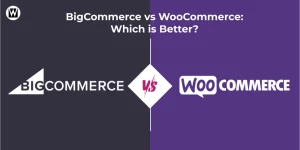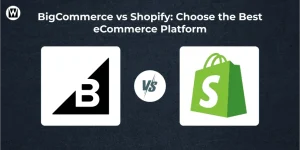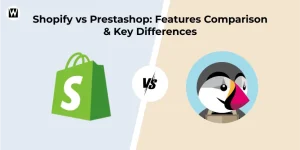WooCommerce vs Shopify: What’s Better for eCommerce Success
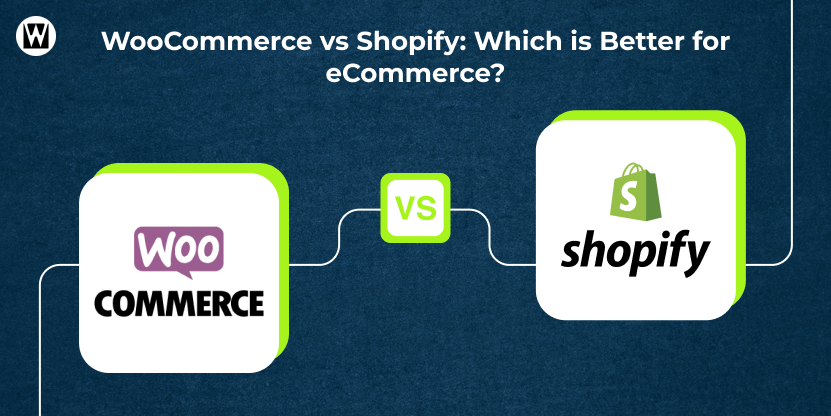
eCommerce is on the rise, and selecting the right platform is crucial to an online store’s success. WooCommerce and Shopify — these names always pop up when defining the best eCommerce platforms. Both have their distinct pros, but which is the right platform for your online business?
Having over a decade of experience in developing eCommerce stores, we have worked with both platforms. With our extensive knowledge, we evaluate the differences between WooCommerce and Shopify based on your business strategy and growth prospects to provide you with an informed decision.
Stick with us as we compare WooCommerce and Shopify and choose the perfect eCommerce platform for your business requirements.
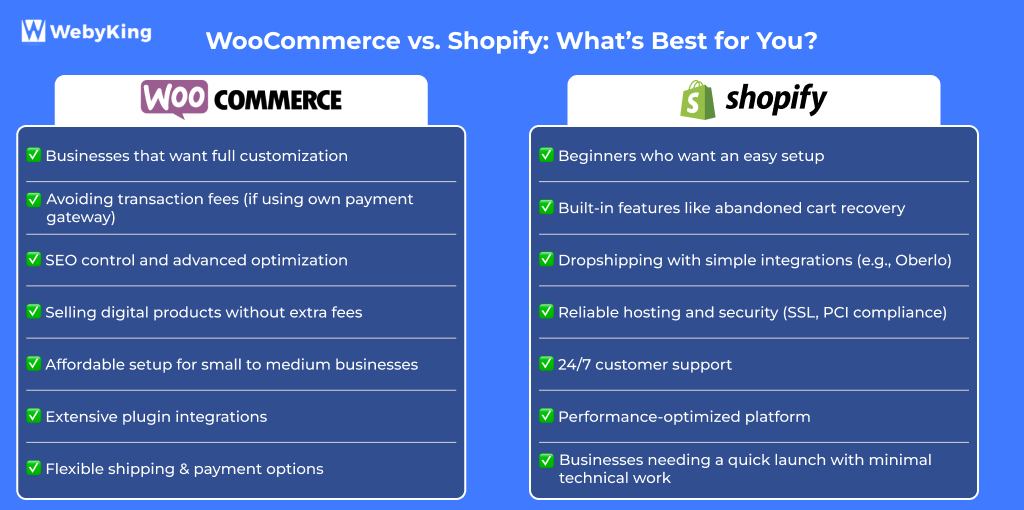
WooCommerce vs Shopify: Ease of Use
WooCommerce
- Built on WordPress, so requires WordPress knowledge and hosting setup.
- Offers flexibility in design and features but needs some technical skills to manage.
- Advanced functionalities would require some extra plug-ins.
- Setup may take longer, particularly for beginners.
Shopify
- A fully hosted solution that manages all the tech part.
- No coding, simple drag-and-drop interface
- Most features come baked-in, so you don’t install additional plugins.
- Setup is fast and makes it ideal for those with no technical experience.
Winner: Shopify
WooCommerce vs Shopify: Affiliate Marketing
WooCommerce
- With WooCommerce, the world is your oyster. Since it’s built on WordPress, you can integrate a variety of affiliate marketing plugins like AffiliateWP or YITH WooCommerce Affiliates.
- These plugins give you the flexibility to customize how you run your affiliate program, track commissions, and manage affiliates.
- The downside? You might need to tinker around a bit, which requires some tech skills. But for brands like Allbirds, who use WooCommerce, this added flexibility can be a game-changer.
Shopify
- On the other hand, Shopify is all about convenience. It has a built-in affiliate marketing feature via apps like Affiliatly or Refersion, which can be easily added to your store.
- Shopify’s simple setup means you can launch an affiliate program quickly and focus on growing your business without worrying about the technical details.
- Big names like Gymshark have used Shopify’s affiliate apps to scale their business, and it’s clear why—it’s fast, easy, and reliable.
Winner: Shopify
WooCommerce vs Shopify: Integration and Addons
WooCommerce
- Offers limitless integration options due to its open-source nature, allowing you to connect almost any tool.
- Requires more technical expertise to install and configure integrations effectively.
- Perfect for businesses that need custom integrations with platforms like Amazon or eBay.
Shopify
- Provides over 6,000 apps for easy integration with popular tools like Mailchimp and Google Shopping.
- Simple, user-friendly setup with no coding required for most integrations.
- Ideal for businesses that want quick, hassle-free setup without complex customization.
Winner: WooCommerce
WooCommerce vs Shopify: Setting Up
WooCommerce
- Requires WordPress to be hosted on a hosting server that you pay for separately, and setup will require a certain level of technical knowledge.
- This allows for tailoring every aspect but may lead to increased initial time spent on setup.
- Great for editors already well-versed in WordPress or who wish to have total autonomy over their website structure.
Shopify
- It is a fully hosted solution with no need for any separate hosting or domain setup.
- Set up your store easily using a simple interface that takes hours, not days, to go live.
- Great for those just starting out and needing the least technical work to kick things off.
Winner: Shopify
WooCommerce vs Shopify: Sales Features
WooCommerce
- Flexible with its list of built-in functionalities and the opportunity to extend it with multiple plugins of sales optimization (upsells, cross-sells, etc).
- No transaction fees, so you keep 100% of the money you make from sales.
- Great when you need some particular customizable features.
Shopify
- Provides an array of built-in sales features such as abandoned cart recovery, discount codes, and limited-time offers.
- Charge transaction fees unless you use Shopify Payments
- Perfect for businesses that require an all-in-one solution without the fuss.
Winner: Shopify
WooCommerce vs Shopify: Dropshipping
WooCommerce
- Easily integrates with dropshipping plugins like AliDropship and WooDropship for a customizable dropshipping setup.
- You have control over supplier selection and store design, but this requires technical setup.
- Perfect for experienced drop shippers who want flexibility in sourcing and customization.
Shopify
- Popular for dropshipping with built-in integrations like Oberlo for finding suppliers and importing products easily.
- Simple to set up, no coding skills are required, and automated inventory management makes it easy for beginners.
Trusted by successful dropshipping brands like Sprocket and Bubba’s Barbecue.
Winner: Shopify
WooCommerce vs Shopify: Pricing
WooCommerce
- Free to install, but you will need to pay for web hosting, themes, and additional plugins.
- Hosting plans can range from $7.99/ per month to $10/ month for shared hosting, but premium hosting for better performance can cost $25+ per month.
- Plugins for specific features (SEO, security, etc.) can also add to the cost, though they can be more affordable for small stores.
Shopify
Offers tired pricing plans:
- Basic plan: $29/month
- Shopify plan: $79/month
- Advanced Plan: $299/month
Each plan includes hosting, SSL certificates, and a range of built-in tools.
2. Charges transaction fees unless using Shopify Payments (2.9% + 30¢ for Basic, lower rates for higher plans).
3. Moreover, Shopify Plus is also a great option for businesses looking to scale their online operations, but the cost is the biggest issue. Its monthly licensing fees start from $2,500/ month and bring many enterprise-level exclusive features to the table.
Winner: WooCommerce
WooCommerce vs Shopify: For Digital Products
WooCommerce
- Perfect for selling digital products, with built-in features to sell downloads, e-books, and courses.
- No additional fees for digital product sales; just need to configure digital delivery.
- Highly customizable for delivering digital content like software or media files.
Shopify
- Supports digital product sales through apps like Digital Downloads and Shopify’s file delivery system.
- Allows you to sell digital products but can charge a fee for each transaction unless you use Shopify Payments.
- Great for simple digital sales but not as customizable as WooCommerce.
Winner: WooCommerce
WooCommerce vs Shopify: SEO
WooCommerce
- Built on WordPress, WooCommerce integrates with powerful SEO plugins like Yoast SEO, allowing you to easily optimize content and improve rankings.
- You get full control over on-page SEO, from customizing URLs and meta tags to fine-tuning internal linking.
- For example, you can create a category system for your blog posts, which helps you organize content and improve user experience.
- Ideal for businesses that need to control their SEO strategy at a granular level.
- However, if you’re not tech-savvy, the setup and maintenance of SEO features can take time and may increase the cost of SEO, especially when managing a large inventory with many categories.
Shopify
- Comes with built-in SEO tools, like customizable title tags, meta descriptions, and an automatic sitemap generation system.
- It’s user-friendly for beginners, but lacks some advanced features that WooCommerce offers.
- For example, Shopify doesn’t have a built-in category system for blog posts, so organizing content as your store grows can become a hassle.
- Apps like Plug in SEO can help enhance your SEO functionality, but you may need to install additional apps for more control over SEO settings.
- Shopify is perfect for businesses that want simple, easy-to-manage SEO without getting into the technicalities.
Winner: WooCommerce
WooCommerce vs Shopify: Market Share
WooCommerce
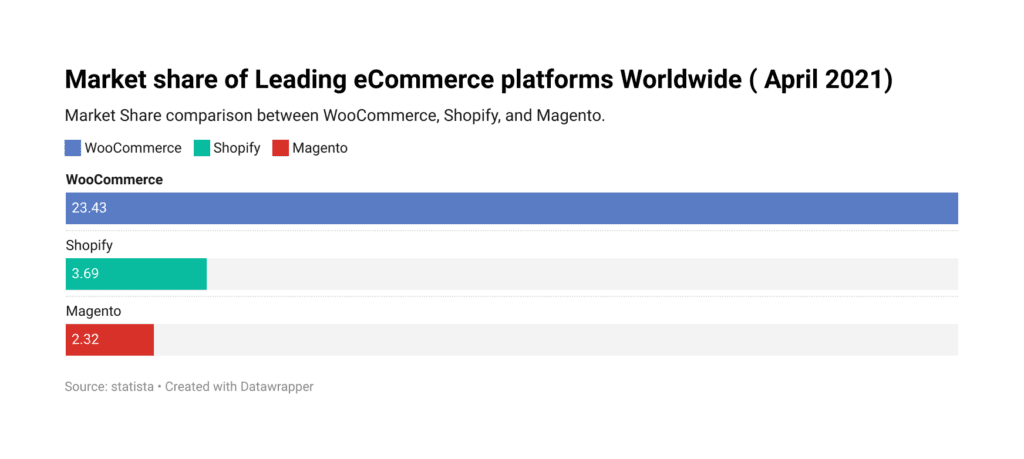
Source: WebAppick
- The total number of downloads of the WooCommerce plugin is 155,691,987 times from WordPress’s official website. U
- sers are downloading WooCommerce at least 30,000 times daily. WooCommerce is one of the leading eCommerce platforms, with more than 23% total market share.
- As of September 28, 2021, W3 Techs’ most recent use statistics show that 42.6% of all websites on the internet are powered by WordPress.
- Additionally, 20% of those 46.6% of WordPress websites use WooCommerce, making up 8.5% of all websites on the internet.
- At least 3.8M live websites are using WooCommerce.
Shopify
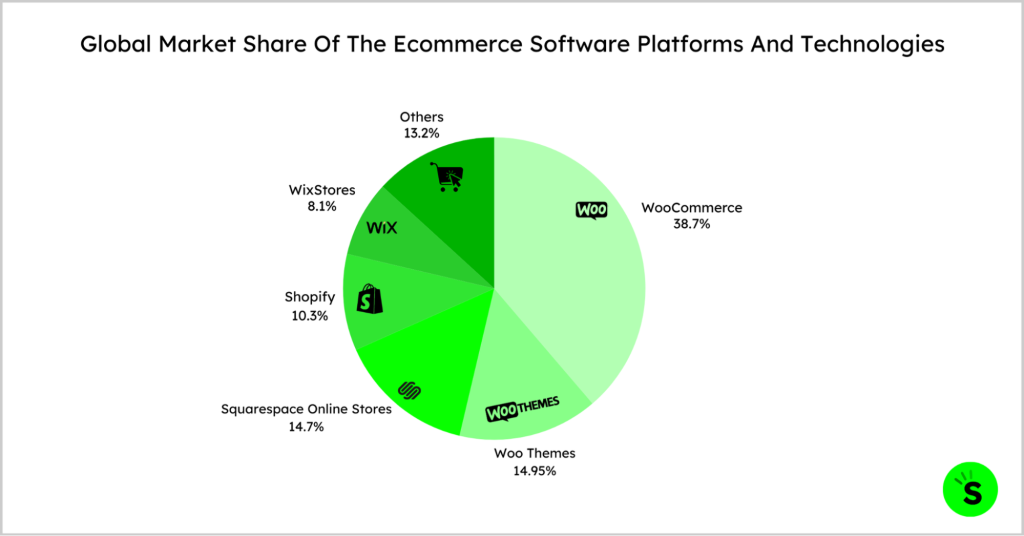
Source: Shopify Free Trial
- With more than 4.6 million websites using Shopify globally, the platform has become one of the top eCommerce platforms.
- Shopify currently holds 4,628,418 active websites and stores across the globe.
- The platform holds a 23% share in the top 1M websites and ranks 4th among the top eCommerce platforms globally.
Winner: WooCommerce
WooCommerce vs Shopify: Performance
WooCommerce
- WooCommerce is a plugin built for WordPress, and its performance largely depends on your hosting provider, the themes and plugin you use, and how well the website is optimized.
- If you are using a good host and have a well-optimized site, WooCommerce can run smoothly even on larger stores.
- However, the more customization you add, the more resources are needed, which could slow things down.
Shopify
- Shopify is a fully hosted platform, which means they handle the performance side things for you.
- Their infrastructure is optimized for eCommerce, with fast loading times and uptime guarantees (99.98%).
- Shopify provides a reliable, seamless experience without much worry about performance on the user end.
Winner: Shopify
WooCommerce vs Shopify: Security
WooCommerce
- WooCommerce itself is fairly secure, but since it’s built on WordPress, it inherits any potential vulnerabilities from the WordPress plugin.
- You will need to keep your site and plugins updated, use strong security protocols (SSL Certificates, firewalls), and invest in additional security plugins to ensure your site stays protected.
Shopify
- Shopify, as a fully managed service, comes with built-in security features. It provides SSL certificates and complies with PCI DSS Level 1 standards, ensuring your customers’ data is always safe.
- They take care of security on their end, so you don’t need to worry about managing updates or handling any potential vulnerabilities.
Winner: Shopify
WooCommerce vs Shopify: Shipping & Payment Gateways
WooCommerce
- WooCommerce gives you full control over shipping and payment gateway options.
- You can use a variety of shipping carriers (USPS, FedEx, UPS, etc) and can also integrate multiple payment gateways, including PayPal, Stripe, and even Bitcoin.
- If you choose to use your merchant account, you can avoid transaction fees altogether.
Shopify
- Shopify offers integrated shipping options with discounted rates and also supports various payment gateways.
- However, if you choose to use a third-party payment gateway instead of Shopify Payments, you’ll face additional transaction fees (ranging from 2% to 0.5% depending on your plan).
- Shopify Payments, on the other hand, has no transaction fees.
Winner: WooCommerce
WooCommerce vs Shopify: Transaction Fees
WooCommerce
- With WooCommerce, you only pay for the payment gateway you use, and if you are using your merchant account, you can avoid transaction fees entirely.
- This makes it a more cost-effective solution, especially for larger stores with high sales volume.
Shopify
- Shopify charges transaction fees unless you use Shopify Payments.
- The fees start at 2.9% + 30¢ per transaction on the basic plan, and they decrease as you move up to higher-tier plans.
- If you use a third-party payment gateway, Shopify adds 2% fees, which can add up quickly.
Winner: WooCommerce
WooCommerce vs Shopify: Developer Cost (A Key Consideration for Business Owners)
WooCommerce
- With WooCommerce, the development cost can vary significantly based on the customizations you want.
- If you’re looking for basic functionality, the costs are minimal. But if you need advanced features, custom themes, or third-party integrations, expect to pay for development time.
- On average, a basic WooCommerce store setup might cost anywhere from $1,000 to $5,000, but the price can skyrocket if you want custom features.
| Development Requirement | Estimated Cost |
|---|---|
| Basic setup with standard theme | $1,000 – $2,500 |
| Custom design or features | $3,000 – $5,000+ |
| Custom integrations or apps | $5,000 – $10,000+ |
Shopify
- Shopify’s development costs are generally predictable and include themes and apps that are either free or come at a fixed cost.
- Custom development is possible, but it’s often more expensive because Shopify is a proprietary platform. You may also need to pay for premium apps, and developers who specialize in Shopify can charge higher fees.
- For a store with custom functionality, expect the cost to range from $2,000 to $8,000 or more.
| Development Requirement | Estimated Cost |
|---|---|
| Basic store setup with theme | $500 – $2,500 |
| Custom features & integrations | $2,000 – $5,000+ |
| Advanced development | $5,000 – $10,000+ |
Winner: WooCommerce
WooCommerce vs Shopify: Support
WooCommerce
- WooCommerce support is primarily community-based, meaning you can rely on forums, documentation, and third-party developers for help.
- There’s no official customer service team available unless you purchase support from a third-party provider.
Shopify
- Shopify excels in customer support, offering 24/7 live chat, email support, and phone assistance.
- If you run into issues, Shopify’s support team is there to help you resolve them quickly, making it a top choice for those who value responsive customer service.
Winner: Shopify
WooCommerce vs Shopify: Scalability and Growth
WooCommerce
- WooCommerce is highly scalable, but you’ll need to invest in robust hosting and continuously optimize your store as it grows.
- Because it’s self-hosted, the platform allows for nearly unlimited customization, meaning you can build exactly what you need as your business expands.
Shopify
- Shopify also scales well, offering a range of plans to suit growing businesses. However, as you scale, you may need to upgrade your plan to access more advanced features.
- Shopify Plus, the enterprise-level plan, can accommodate large businesses with complex needs.
Winner: Tie
WooCommerce vs Shopify: Which Platform Comes Out on Top?
WooCommerce and Shopify are outstanding eCommerce platforms. However, both platforms have their strengths and weaknesses.
For tech-savvy users who desire total control over their business and are at ease with hosting and maintenance, WooCommerce shines in terms of customisation and versatility.
With integrated hosting, security, and round-the-clock support, Shopify is a great all-in-one option for novices and those seeking a hassle-free eCommerce experience.
Your technological know-how, financial constraints, and preferred degree of control will ultimately determine which option is ideal for your online store. You have a choice between WooCommerce and Shopify!
If you need any help with WooCommerce Development or Shopify Development, feel free to get in touch with us!
Frequently Asked Questions
Is WooCommerce better than Shopify for beginners?
So, since Shopify built an all-in-one solution, it’s easier for beginners to use; WooCommerce, on the other side, is more flexible but this comes with higher setup needs.
Which is more cost-effective, WooCommerce or Shopify?
WooCommerce is also less expensive in the long run, as it’s a free plugin for WordPress, while Shopify has monthly fees starting at $29.
While some eCommerce platforms allow better scaling than others.
Both platforms can handle high-traffic volume effectively, but due to Shopify’s built-in tools, it usually provides a more straightforward scaling experience compared to WooCommerce, where you’ll need to put in extra work to build out functionality to aid in scaling.
Is WooCommerce or Shopify better for SEO?
When compared WooCommerce provides better SEO control and features, but not as flexible as Shopify’s built-in SEO structures.
Does WooCommerce or Shopify provide better customer support?
Shopify has 24/7 support, and WooCommerce has community forums and third-party support.
Which is easier to set up with payment gateways, WooCommerce, or Shopify?
Shopify easily integrates with many payment gateways, while WooCommerce has more flexibility but can require more setup.
Does WooCommerce or Shopify provide better design options?
Shopify has a variety of professional themes to choose from whereas WooCommerce offers highly customizable templates requiring developer support.
Which platform is better for managing inventory, WooCommerce or Shopify?
As a result, Shopify offers a more seamless and automated inventory management, whilst WooCommerce needs plugins for advanced features.

Ravi Makhija, the visionary Founder and CEO of WebyKing, is a seasoned digital marketing strategist and web technology expert with over a decade of experience. Under his leadership, WebyKing has evolved into a premier full service web and marketing agency, delivering innovative solutions that drive online success. Ravi’s deep understanding of the digital landscape combined with his passion for cutting-edge technologies empowers him to consistently exceed client expectations and deliver results that matter.

